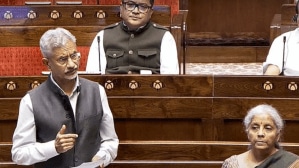CPI to present documentary on party MLA Krishna Desai’s life tomorrow
The visual homage contains recollection of Desai’s life and his impact on Mumbai’s trade union as well as political scene by people who worked with him.
 Prakash Reddy with a bust of Krishna Desai. Express
Prakash Reddy with a bust of Krishna Desai. ExpressThe murder of Communist Party of India (CPI) legislator Krishna Desai, committed on a rainy night in Tavari Pada at Lalbaug on June 5, 1970, is said to have paved the path for the Shiv Sena’s entry into state Legislative Assembly in October 1970.
Fifty-two years later, with the Sena governing the state, the CPI on June 5 will showcase a visual chronicling the life of Krishna Desai, a trade union leader, whose death is said to have sown the seeds that led to Sena’s dominance in the working class neighbourhoods of central Mumbai.
The visual homage contains recollection of Desai’s life and his impact on Mumbai’s trade union as well as political scene by people who worked with him. It also contains the narration of his wife Sarojini Desai on what transpired on the June 5 night and the hours leading to his murder.
The visual homage that has been made by the CPI’s Lalbaug unit is an attempt by the party to gather, preserve and interpret the voices and memories of people, communities and participants in seminal events associated with the party’s history in Mumbai. While the CPI has been holding an annual commemoration event every year on June 5 since Desai’s death, this is the first time that it has decided to come out with a documentary on his life.
“The idea behind this is to collect memories and personal commentaries of historical significance that are associated with the party through recorded interviews. There are so many events pertaining to the party and its contribution to seminal events in the city as well as state’s history that not many people, especially youngsters, are aware of,” CPI state secretariat member Prakash Reddy said.
Desai was a mill worker who emerged as a popular union leader post Independence. He went onto win the municipal corporation elections and became a corporator in 1952. He subsequently went on to win the MLA elections from Parel in 1967 on a CPI ticket and was a name to reckon with in the Lalbaug Parel area – the heartland of mill workers. He was instrumental in creating and strengthening the Rashtra Seva Dal in Mumbai, which was supposed to be a band of young men and a cultural front of CPI.
The Sena, which was trying to consolidate its base in Mumbai, got into a confrontation with the CPI for political dominance in the area and saw the Rashtra Seva Dal and Desai as a threat.
On the night of June 5, 1970 Desai, along with one of his associates, stepped outside his house after being told that someone wanted to meet him. A short distance away, he was waylaid by a group of men. Two swords were thrust into Desai’s ribs killing him on the spot.
Sena founder Bal Thackeray issued a statement terming Desai’s death as unfortunate. However, 19 Sena supporters were arrested for the murder and 16 were subsequently convicted.
While the murder is deemed to be a dark and untalked about chapter in Sena’s hagiography, the murder paid political dividends for the party. In a move that symbolised its growing popularity, Sena candidate Wamanrao Mahadik defeated Desai’s widow in the bypolls held in October 1970 for the same seat by 1,679 votes. The win meant Mahadik became the first-ever Sena MLA to enter the Maharashtra Assembly. The CPI continued to remain a formidable force in the city with its candidate Roza Despande winning a Lok Sabha bypoll in 1974 from south central Mumbai.
While the party went on the lead many agitations of mill workers in Mumbai, the loss of Desai and the changing face of Mumbai — which saw the wanton shutting down of mills and the displacement of the city’s mill workers — meant that the CPI was not the same force that it used to be.
The 1992-93 Mumbai riots, which resulted in a spatial transformation of the city along religious lines, meant that the CPI lost its grip on the city even as Sena ascended the political landscape of the city.












